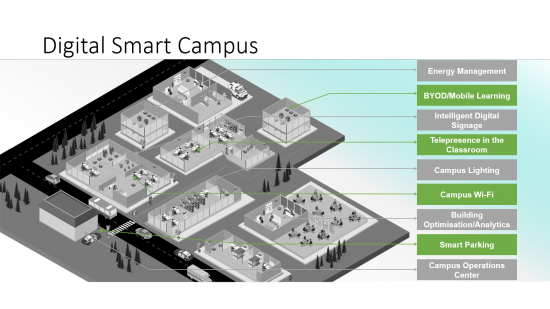I remain excited about Cisco’s Digital Ceiling framework and how it is making inroads in the societal landscape of business, governmental, and educational institutions. In particular, Digital Ceiling solutions can significantly impact key verticals like Education. New solutions are needed to support growing trends in education relative to workstyles, as well as physical aspects of school campuses.
The phrase, “going to college,” has a whole new meaning in the digital age. In addition to traditional brick and mortar schools, there are a host of educational platforms like distance learning, online tutorials, and webinars. And with the competitive nature of today’s job market, higher education is more important than ever.
Many of the changes in the field of education are being driven by trends in technology:
- Mobility is a given for the current generation of students and this extends far beyond basic connectivity. In fact, learning itself is becoming mobile.
- Most of today’s students are digital natives who have grown up with social networking tools. They expect the same type of interactions on campus and in their classes, with the same degree of ease and access.
- Video creates new opportunities to expand the availability of education while maintaining face-to-face interactivity.
Technology has broadened the opportunity for learning by making every personal computer, smartphone and tablet, a potential academic resource. This is fertile ground for Cisco in its ongoing quest to facilitate the ways we work, live, play, and learn. In addition to the critical role of the network in the connectivity of devices, the Digital Ceiling provides the next generation of connectedness for Education with smart classrooms and smart campuses.
Cisco’s Digital Ceiling framework connects disparate building domains (like lighting and building automation) and services over a single IP network. For the connected campus, Digital Ceiling solutions enable business outcomes like:
- Wi-Fi deployment planning based on where students/staff are actually dwelling
- Way-finding and activity integration within Apps
- Guided tours using mobile Apps and devices
- Equipment tracking
- Safety and emergency procedure communication
- Available lab/room finder/bookings
- Transportation notifications and wait times
- Bookstore/campus store communication
- Friend/staff finder Apps

Real World Solutions
I would like to highlight a couple examples of the Digital Ceiling solutions in full action. The first case is the New England Institute of Technology (NEIT) in Rhode Island — a private, accredited, non-profit university offering Associate, Bachelors, Masters, and Online degrees in more than 50 programs. Their objective was to attract students to campus that were from outside the usual campus radius, and to fill enrollment slots with a new group of students. They also sought to support mobile digital technology in their new dormitory, enable the latest technology for classroom and lab learning tools, and become a more competitive technical college.
Cisco’s expertise in intelligent networking solutions and forward thinking architecture made us the only appropriate candidate for this initiative. To address their needs, we have been working with one of our Digital Ceiling’s technology ecosystem partners, Molex, to deliver Network-Powered lighting via uPOE (universal Power over Ethernet). The business outcomes expected are an increase in NEIT revenue from a larger population of new students (nationally and internationally); a vastly improved student experience resulting from the enhanced technology; and a reduction in the campus’ operations costs.
The second example I want to mention is the Mobile County Public School System in Alabama. It is the largest school district in the state, with 100 schools serving more than 59,000 students. The School System partnered with Cisco to assist them in using technology and digitization to create a better learning environment. Their objective was to better engage students in the learning process through the use of technology such as smartboards, color tunable lighting, specialized teacher apps, and other tech integration.
Cisco implemented a number of Digital Ceiling solutions in the School System’s classrooms, hallways, and administrative buildings to allow easy integration of technology into their teaching. As a result of the Network Powered lighting solution alone, the School System has lowered its utility bill by 50% and is poised to quickly adopt the latest instructional technology.
So, as you can see, Cisco’s Digital Solutions are created from a customer-centric perspective and aligned with business imperatives for increased relevance. If you are interested in learning more, check out these resources:
Also, the 5th annual Internet of Things Day is April 9th with lots of great events going on including a 24-hour #IoTday tweet chat where we can talk about interesting solutions like Digital Ceiling.
Be sure to give me your feedback in the comments section or engage with me on Twitter @TonyShakib. What do you think of Cisco’s Digital Ceiling framework?
CONNECT WITH US